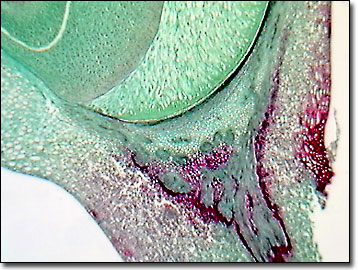Brightfield Digital Image Gallery
Zea (Corn) Kernel
Corn is the common name for the cereal grass widely grown as food for humans and animals. Along with wheat and rice, it is one of the world's chief grain crops and the largest crop grown in the United States. Native to the Americas, corn (Zea mays) is the domesticated variety of the Zea grass family, and was originally cultivated by Native Americans 8,000 to 10,000 years ago.

View a high magnification image of a Zea (Corn) Kernel.
Teosinte (Zea mexicana), a perennial wild corn once thought to be extinct, still grows today in Mexico. Since its introduction into Europe in the fifteenth century, corn cultivation has spread to all areas of the world where it can be grown. In addition to providing food for human consumption, corn is also used as livestock feed. The inedible parts, such as the cob and husk, are used as raw material in industry.
There are many varieties of domestic corn, most of which were developed through aggressive breeding programs during the twentieth century. The most important advance in corn cultivation came in 1933, with the introduction of hybrids. The thousands of hybrids that have been produced since then have increased corn yields and made it possible for the crops to flourish in almost any combination of soil and climate. Since the discovery of teosinte in 1978, new breeding programs have been underway to develop a perennial corn variety and hardier, pest resistant plants.
Corn plants have an erect, solid stem, rather than the hollow stem characteristic of most other grasses. They vary widely in height, ranging from 2 feet (61 cm) to 18 feet (5.5 meters), depending on the variety. The plants have long narrow leaves that grow alternately along the length of the stalk. Each stalk terminates with a tassel bearing tiny flowers that produce pollen, the male gamete. The ear, covered by modified leaves called husks, is the pistillate (female) part of the plant and bears up to 1,000 seeds. A cluster of silk fibers protrudes from the tip of the ear, each fiber attached to an individual ovary. Pollen from the tassels is carried by the wind and falls onto the silks. There, it germinates and grows down through the silk until it reaches the ovary, each of which develops into a kernel of corn.
Contributing Authors
Cynthia D. Kelly, Thomas J. Fellers and Michael W. Davidson - National High Magnetic Field Laboratory, 1800 East Paul Dirac Dr., The Florida State University, Tallahassee, Florida, 32310.
BACK TO THE BRIGHTFIELD IMAGE GALLERY
BACK TO THE DIGITAL IMAGE GALLERIES
Questions or comments? Send us an email.
© 1995-2025 by Michael W. Davidson and The Florida State University. All Rights Reserved. No images, graphics, software, scripts, or applets may be reproduced or used in any manner without permission from the copyright holders. Use of this website means you agree to all of the Legal Terms and Conditions set forth by the owners.
This website is maintained by our
Graphics & Web Programming Team
in collaboration with Optical Microscopy at the
National High Magnetic Field Laboratory.
Last Modification Friday, Nov 13, 2015 at 01:19 PM
Access Count Since September 17, 2002: 12509
Visit the website of our partner in introductory microscopy education:
|
|
